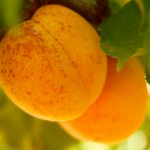 Perfect Ripeness
Perfect Ripeness
The most exquisite experience on the farm at the moment is to pick a perfectly ripe apricot right off the tree. The craving for these delicate, aromatic, and sweet fruit is almost irresistible, just trying to write about it makes me want to walk out and get one.
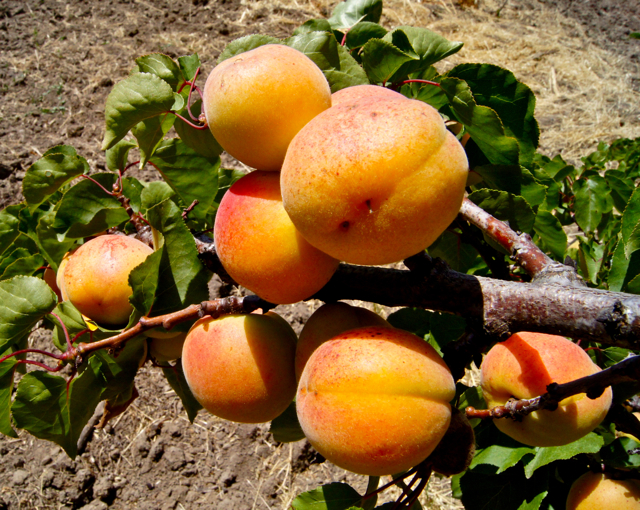
Perfect ripeness is hard to describe, it is the fruit that calls out, the fruit that gives a little when touched and releases itself into one’s hand. I will scan a tree and look for the telling colors of rich orange and red, any hint of green close to the stem means the apricot can still ripen a few more days. Once I set my eyes on that perfectly colored fruit I will gently touch, squeeze, and tug all at the same time. When fully ripe, it will just drop into the palm of my hand. You ask me what I love about farming – it is this nourishing experience of being rewarded by the land we steward.
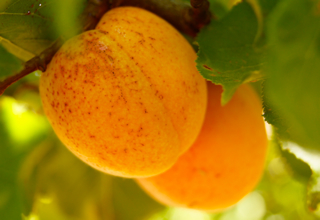
Come join us on the farm this Saturday to celebrate the Summer Solstice, and experience for yourself the reward of picking and enjoying a fruit directly from the plants and trees growing in our fields and orchards.
Saturday, June 21st – Solstice Celebration and Community U-picks
12:00 pm – 5:00pm: Community U-picking – strawberries, raspberries, and apricots
5:00 pm – Dark: Celebration and Potluck
Parking: Please follow the signs.
Parking for the Strawberry and Raspberry U-picks is at our 1275 Green Valley Rd Entrance (click for directions)
Parking for the Apricot U-picking, Celebration and Potluck is at our 172 Litchfield Lane Entrance (click for directions)
Overflow parking area at 1275 Green Valley Road. Parking at 1275 Green Valley Road means you will have to walk a ways – about a quarter mile, including a short distance up a fairly steep hill – to get to the main area of events. Save gas and carpool!!
Remember to bring jackets and sweaters as it gets cool later in the day, and a flashlight for navigating back to your car if you stay until after dark.
Potluck Details
- Everyone please bring something to share – an entree, a salad, a dessert – whatever you like! We never organize it more than that and always seem to have a nice variety.
- How much to bring? If in doubt, bring more, as we always seem to eat it all up! 😉 In all my years at Solstice Celebrations I have not seen folks going home with lots of left-overs!
- Please bring a serving utensil to go with your dish!
- Put your name on your dish and serving utensil with some masking tape or something, in case they get separated, and so we know who they belong to if they get inadvertently left behind.
- Please provide an ingredient list for your dish on a piece of paper or 3×5 card so folks with food allergies or special diets will know what they can and cannot eat.
- Where to put your pot-luck items when you arrive? We will have several tables for placing your pot-luck items on out near the fire circle. If you have something that needs to be refrigerated, you can pop it into our walk-in cooler to the right of the breezeway in our “upper barn” (Litchfield Ln Entrance). If it just needs to stay cool (not in the heat of your car), you can also put it on a table inside the breezeway/classroom area until pot-luck time. If you arrive closer to pot-luck time, simply bring it to the table area. We have extremely limited facilities for re-heating anything, so please don’t plan on that if you can help it.
- Beverages – There will be water and lemonade, but feel free to bring additional beverages for your own consumption or to share.
- We encourage you all to bring your own picnic plates, cups, bowls, silverware etc. in order to minimize unrecyclable garbage. We will have a washing station, where you can rinse them when you are through eating.
- And bring a blanket to picnic on, or your own chairs if you prefer.
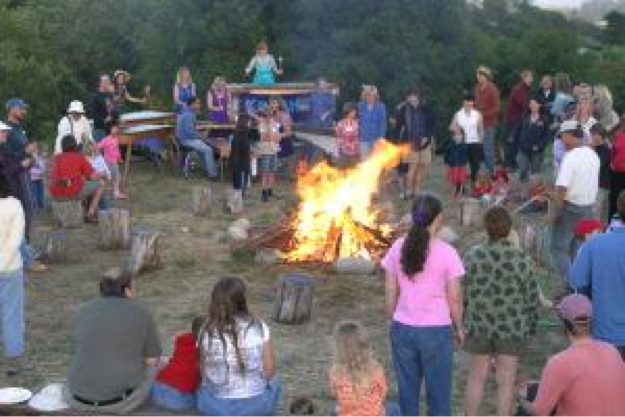
The season’s first rainmaker is predicted to approach the Central Coast this Friday and Saturday. Although no more than 1 inch of rain is expected to fall, it is enough to give us some drought relief. After almost six months of harvesting every single day, we are tired and dream of slowing down a bit during the hopefully rainier months ahead.

Fuji Apples ready for harvest.
With the exception of a few more rows of Fuji apples needing to be picked, our apple harvest is done for the season. Soon all the apples going into our shares (mostly our sweet Fuji’s) will be taken out of cold storage. After this next rain the strawberries and tomatoes will also officially be done, plowed back into the soil with a winter cover crop planted in the fields to rest and recharge the soil. The only fruit still being harvested for awhile longer are the pineapple guavas and, starting in December, our Meyer lemons should fully yellow to be enjoyed in our shares.

Frosty Cauliflower Field
Since crops are turning their energy inward to form seeds or store their energy in roots or trunks, winter is a good time to sow slower growing root crops that store in the ground over several months. The winter shares are a wonderful opportunity to enjoy both the nutrient dense earthy flavors of many of the root crops we grow (parsnips, celeriac, carrots, beets, and turnips), as well as the unique crisp textures and sweet flavors brassicas develop when temperatures drop into the thirties during the frostier winter nights ahead.
When the rain finally starts falling I will walk the farm to breathe a sigh of relief, surrendering to the inevitability of the more sinister decay of the farm’s crop lifecycle. The rotting windfall apples and tomatoes on the ground, I recognize, are the secret of fertility and the regenerative power of our earthly existence. I wish you all a spooky and safe Halloween!!
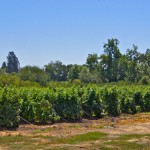 Ever Changing Fields – July 2014
Ever Changing Fields – July 2014
While some crops, like raspberry and blackberry canes, remain in the same place for a couple of years, as the season progresses most crops are rotated through the fields. Take a walk with us to see the changes.
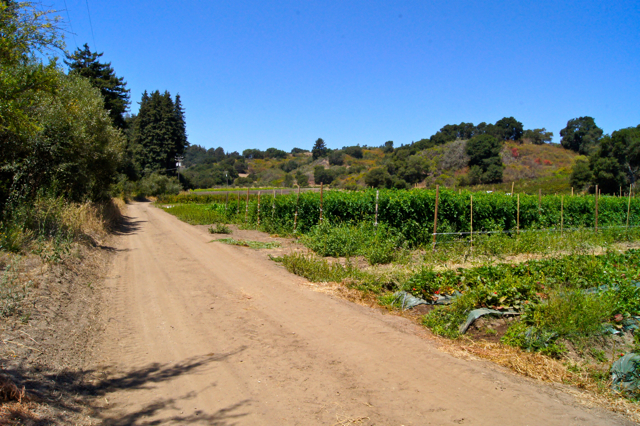
In January 2013 this portion of field was flooded, and now there are rows of raspberries and a corner of our community strawberry field.
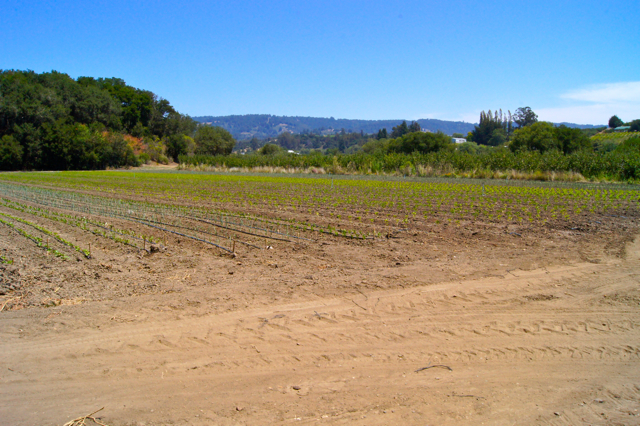
A little over two weeks ago, this field was being plowed. Now it’s full of transplants, crops that will be ready for harvest within the next month or so.
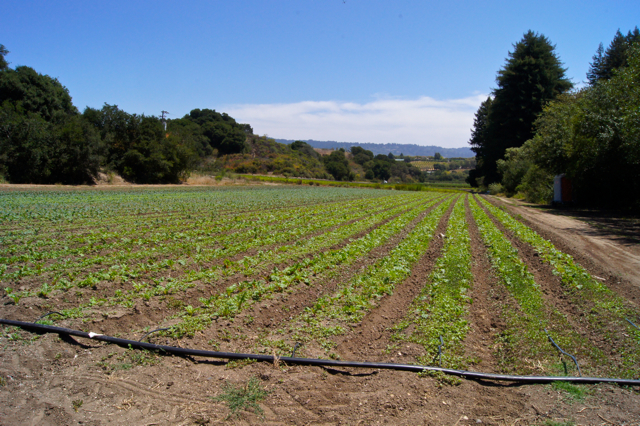
The chard in this field was transplanted about three weeks ago. Back in December, it was full of cauliflower wearing a frosty coat.
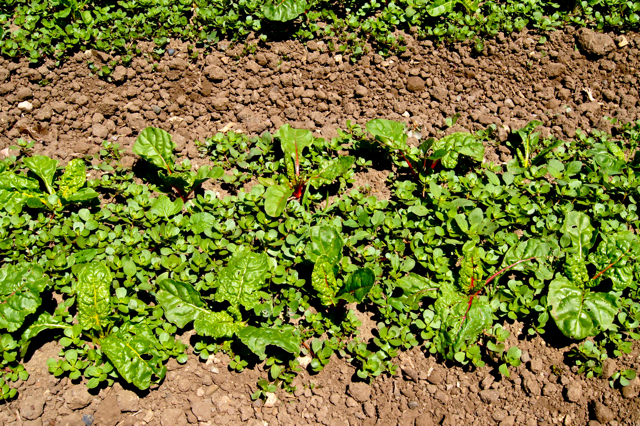
The chard has a competitor – purslane. Though edible, purslane is considered a weed and can quickly take over a field if left unchecked.
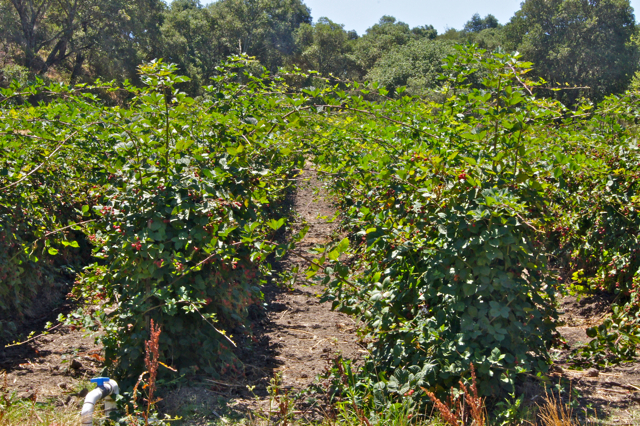
These blackberries also went through the December frost – so thick in between the rows it looked snow.
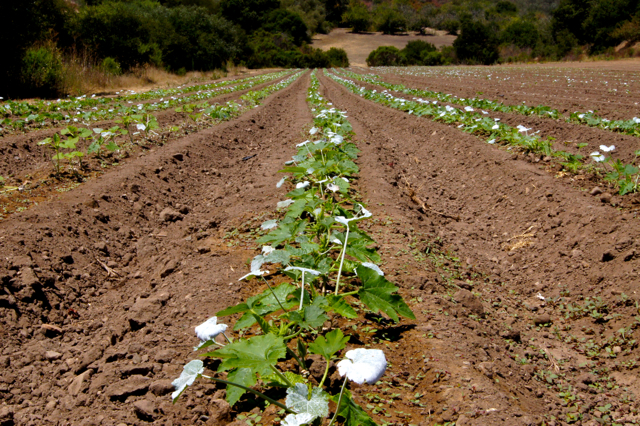
Two weeks ago this field was just freshly formed rows. Now it’s full of winter squash. The white leaves are the original ones from the transplants, dusted with clay to hinder pests like flea beetles.
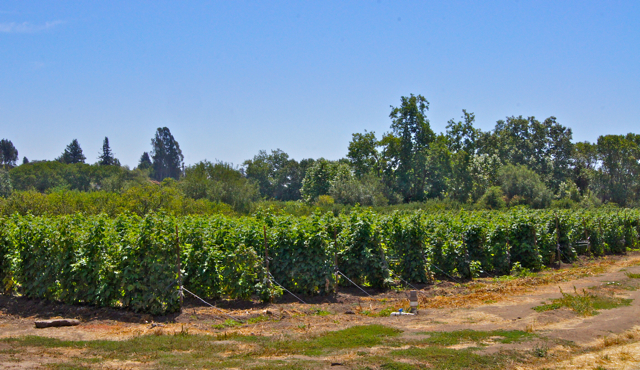
This field of first year raspberry canes was last summer’s community tomato field. And before that, in March 2013 it was full of cover crop.
Be sure to mark your calendar and join us on Saturday, August 16th for a Community Farm Day and Dry-farmed Tomato U-pick. Come take your own field walk, and enjoy the Farm!
Together with my daughter, Elisa, I explored this season’s first maturing pepper field in search of the coveted “Chiles de Padron”. Although still a couple of weeks out before we have enough to put in the shares, we were able to fill a paper bag to enjoy for dinner.
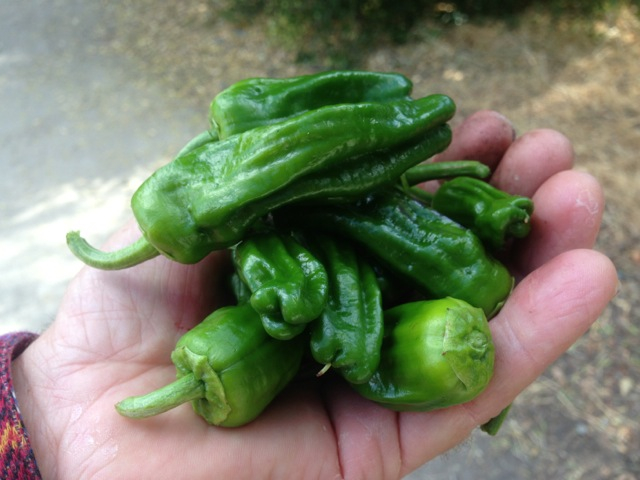
First Padron Peppers
The best way to prepare Padron Peppers is to simply throw them onto a hot cast-iron skillet until they are all blistered, sprinkle some good quality sea salt on them and they are ready to be enjoyed. Grab them by the stem; the little peppers you’ll finish off with a single bite, the larger ones no more than 2-3 bites. I promise, after tasting a few of them it’ll be hard to resist reaching for more. Elisa and I snacked down an entire bowl while preparing dinner.
Most of the time Padrons are mild, yet some exemplars, often the larger ones, can be quite hot. Typically, there is no way of determining whether a given pepper will be hot or mild, short of actually eating it. In our family it always turns into a fun game of daring each other to bite into one that looks spicy.
The first sweet Italian Long-Peppers (Corno di Toro) are being harvested this week, replacing broccoli in your shares. Due to the dry winter you will have noticed that many of our crops are maturing almost 2-3 weeks earlier this year. The second block of green beans will be ready for harvest next week, with the first tomatoes I anticipate showing up in your shares in a week or two (the first cherry tomatoes are going in this Thursday’s extra fruit option).
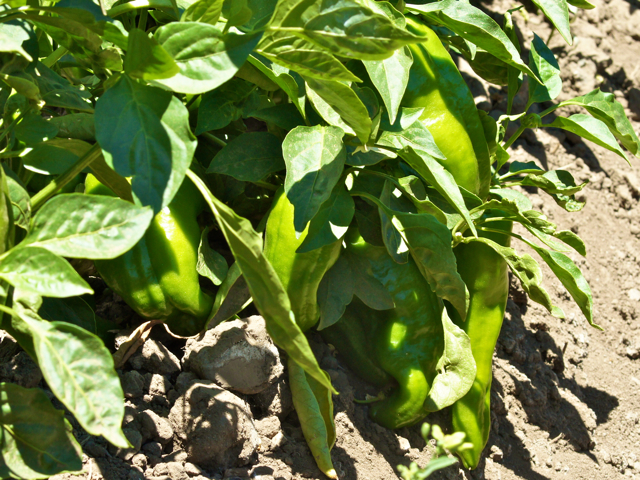
Corno di Torro Peppers
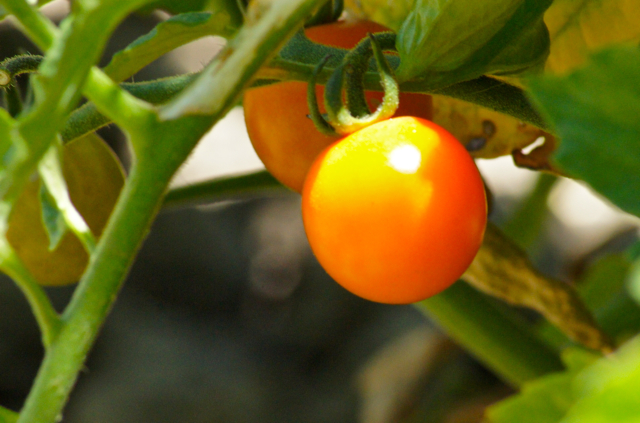
Sungold Cherry Tomatoes
I love the anticipation embedded in the seasonality of growing food. As a farmer it is exciting to anticipate the maturity of a crop, it is the highlight of the growing cycle, the time we can offer and share the results of our efforts. I like to honor new crops coming into season, harvested for the first time, by highlighting them in a family meal, a simple way to celebrate and be thankful.
That’s the advantage of local food. To experience the pleasure and taste of the seasonality of crops grown right here on our farm and harvested the same day you may prepare them into a nourishing dish. Mealtimes for our family – especially dinner – are important moments to slow down to be with each other. The quality of the meal we share contributes directly to the atmosphere of our time together as a family
At Live Earth Farm, we like you to experience a direct relationship to the land and people who grow the nourishing crops you eat. This intimacy and openness of the farm to its community has always been a guiding principle and a source of pleasure that continues to nourish our passion for farming.
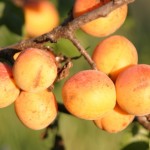 Oh Joy – Picking & Tasting in the Fields
Oh Joy – Picking & Tasting in the Fields
It feels as if the season is turning into summer a little earlier than usual … yesterday I was fixing an irrigation line in one of our apricot orchards and was surprised when a branch of orange fruit caught my eye.

These ‘cots may look ripe, yet they’ve got another week or two to go before they’re ready to pick.
My hand instinctively reached for them, and to my surprise a few of the fruit were soft. I had to stop everything – my whole body was excited with anticipation of tasting the very first ripe “Blenheim” of the season.

Farmer Tom enjoying his first apricot of the season. Though others have looked, we have yet to find his secret patch of ripe ‘cots.
What a treat, all my senses celebrated savoring this exquisite fruit. For a moment all my worries were set aside, I was just filled with gratitude and joy. It’s hard to explain in words, it’s something you’ve got to go out and try.
Come out and join us this Saturday for the Season’s first Community Farm Day and Strawberry U-Pick event. It’s fun to experience and taste something directly from our fields and orchards – a way to understand what it takes to enjoy a good meal each day.
Details
When: Saturday May 31st, 10am – 3pm
Where: Enter the farm at our “Green Valley Entrance” at 1275 Green Valley Road (click here for directions)
Parking: Please follow the parking signs when you get here
Cost: No entry fee. U-harvested strawberries will only cost $2.50 basket (50 cents will benefit the Discovery Program).
Limit: There may be a limit on how many strawberries one gets to pick, however we will offer extra strawberries at our Farm Stand if you like to stock up. We will also offer refreshments and some healthy foods and snacks if you like to explore and picnic on the farm.
Other: We ask that you do not bring dogs to our farm; please leave them at home.
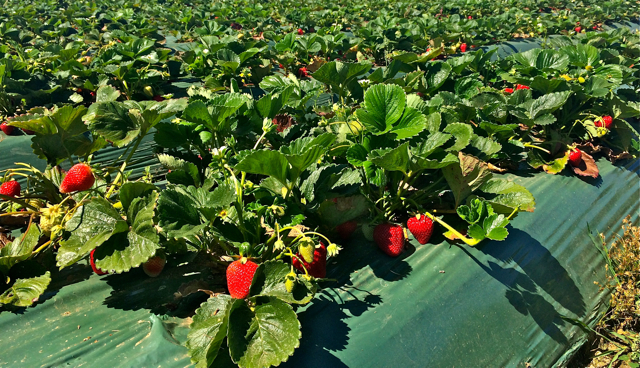
The Community Strawberry Field is ready and waiting for you. 🙂
 “Food What?!” – Welcome Back
“Food What?!” – Welcome Back
With every passing week the workload is ratcheting up another notch. The increasing number of tasks mimics the abundance in the field and, since most of them are manual by nature, work often starts at dawn and sometimes doesn’t stop until dusk.
You will notice green beans and red raspberries in your shares this week. Both are popular crops, but time consuming to pick. With apricots also ripening and ready to be added to the harvest schedule, you can imagine how excited we are to welcome back 25 youths from the “Food What?!” program to give us a helping hand.
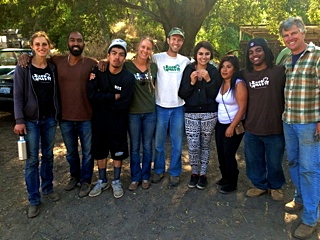
Food What?! Team Leaders
Similar to last year, every Friday for the next 5-6 weeks this wonderful group of teens will circle up at 9AM under the large oak tree by our Green Valley Barn ready to take on field tasks scheduled for that day.
What I like about this partnership is that teens are empowered to directly engage in the operation of a real working farm, where they have the opportunity to work side by side with our employees, experiencing literally from the ground up the fruits of their labor. Whether it’s weeding a 1 acre block of peppers or cutting and packing lettuce for a weekend market, these apparently simple tasks teach a lot about one’s stamina, ability to work in a team, learning new skills and paying attention to detail, under often unaccustomed outdoor conditions. I like the name “Food What?!”, it reflects what is at the core of our well-being – understanding our connection to healthy food and where it comes from.

Food What?! teens helping with the carrot harvest.
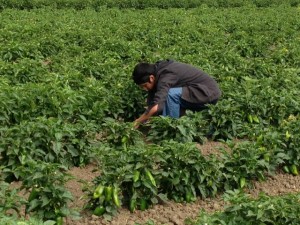
Weeding rows of pepper plants.
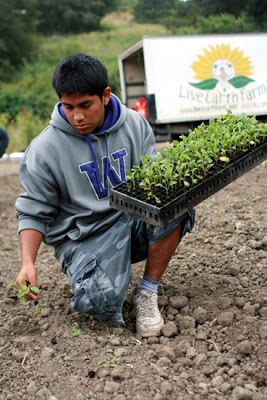
Planting seedlings.
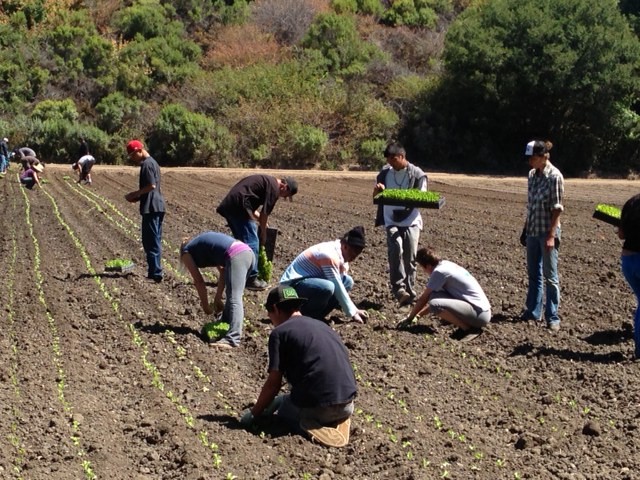
The team planting many flats of seedlings.
 Just the Beginning!
Just the Beginning!
Here is a picture I couldn’t resist sharing with you all since many of you have met Chella, our “ferocious” Farmdog, and Clover, the farm’s 2 week-old baby Pony.

And, I hope you will join us here on the farm for our first Community Farm Day/Strawberry U-Harvest on May 31st (click here for more details).
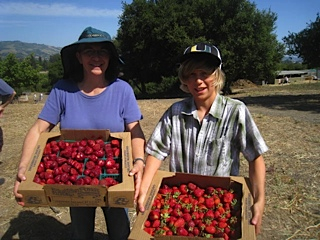
Happy members with their strawberry harvest.
Now, on to News & Reflections –
Farming can feel like a dynamic entanglement of priorities where there is always more work waiting to be done. At the moment we are in the middle of Spring’s crescendo having to orchestrate planting and sowing schedules to coincide with field and soil cultivation, time weeding and watering schedules, and balance harvest, packing, and deliveries to meet weekly orders for stores, restaurants, CSA shares and Farmer’s markets.
In the orchards we are watering, thinning fruit, weeding, and keeping an eye out for insect and deer damage. The tomatoes and raspberries are being staked – plants are growing so fast it’s important they get trellised to grow upright and not fall over.
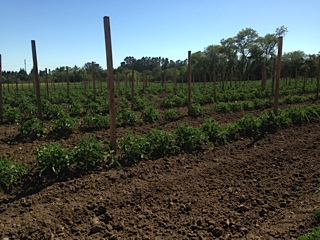
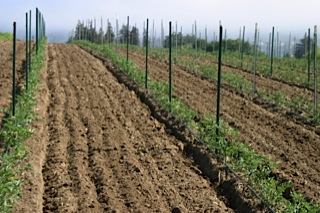

At this time of year equipment breakdowns are always a bit stressful since timing of certain tasks are thrown off. Yesterday, for example, our flail-mower developed a big crack in the housing that holds the shaft and bearing which will take several days to fix, resulting in a delay to set up the irrigation in one of our orchards and tilling a field where the next lettuce crop will be planted. Breakdowns are unavoidable, however we try to minimize them by doing daily routine inspections and performing most maintenance and preventive repairs right here on the farm.
Like weeds, the list of chores right now never stops growing and their harmonious orchestration wouldn’t be possible if there wasn’t an amazing team of dedicated and super motivated employees who wear many hats, paying attention to the well-being of the farm’s soils, crops, animals, and the diverse community of people – workers, members, school children, and the many customers throughout the Bay Area we deliver our fresh, delicious produce to.
Have a wonderful Memorial Day weekend!
 Every Vote Counts – So does every Meal
Every Vote Counts – So does every Meal
Wednesday morning I was helping load the delivery truck and it made me happy to think of all our members who will receive their shares. Freshly harvested the day before, they will most likely be transformed into a healthy home cooked meal by the evening.
Most of you will agree that a weekly CSA share makes a small but not so insignificant difference in our daily lifestyle. To prepare and cook with the produce we receive takes time, it slows us down, and it creates a breather. In our family it’s a ritual to come together to prepare and share a meal at least once a day – usually dinner. Sharing food becomes the conduit for bridging time and space and renewing our bonds as a family. It’s a moment to catch up on what happened that day, an opportunity to complain, praise, reflect, laugh, and share the latest news about work, school, friends, and family.
It may seem like an insignificant and humble act how we decide to eat our meals and what we decide to eat, but I am convinced that collectively it plays an enormously important role. Most of us eat three meals a day and although we know food is grown on farms we don’t know what farms, what kind of farms, where the farms are, or what kind of skills and practices are involved in farming. Many in our society have grown so removed from the source of where food comes from that food is pretty much an abstract idea until it shows up on a grocery shelf or on the table. What motivates me as a farmer is to grow food that nurtures and reestablishes the intimacy of food and community. It is, I believe, a vital building block to a healthier and more peaceful world.
The election may be over and one might question how much an individual vote really matters in the current political spectacle, but outside of that spectacle I can’t help but be an optimist when I see so many people in the food and farming communities making a real difference in establishing a participatory nourishing food system for all.

A double rainbow at the Farm during Saturday’s rain storm.
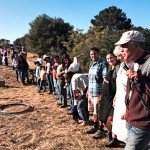 Sharing and Celebrating
Sharing and Celebrating
Teaching children about the natural world should be treated as one of the most important events in their lives.
– Thomas Berry
Many thanks to all who participated and helped make last Saturday’s Solstice Celebration another wonderful community event.
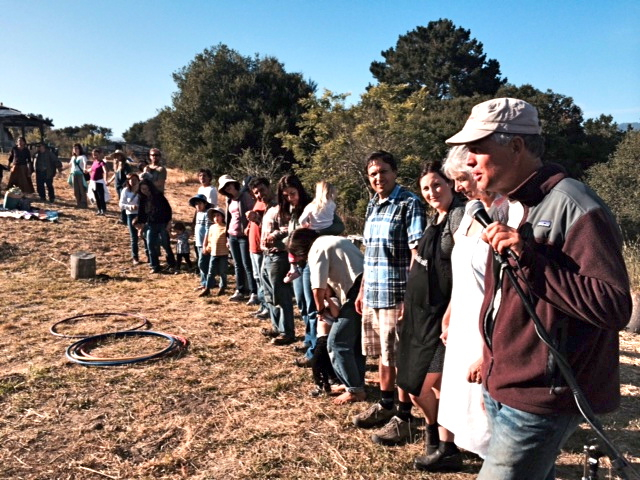
The farm was buzzing with activity as people explored, picking strawberries, apricots, and raspberries. Many children didn’t need to get their faces painted, since theirs were naturally stained with berry and apricot juice.
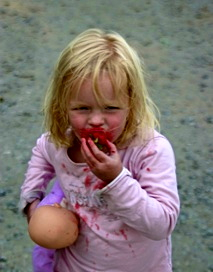

The usual and expected tractor rides, pizza baking, mingling with the farm animals, exploring the strawbale fort, lighting the bonfire and enjoying the rhythms of marimba music, continue to inspire a sense of community and instills a connection to the land and the crops grown here that nourish us.
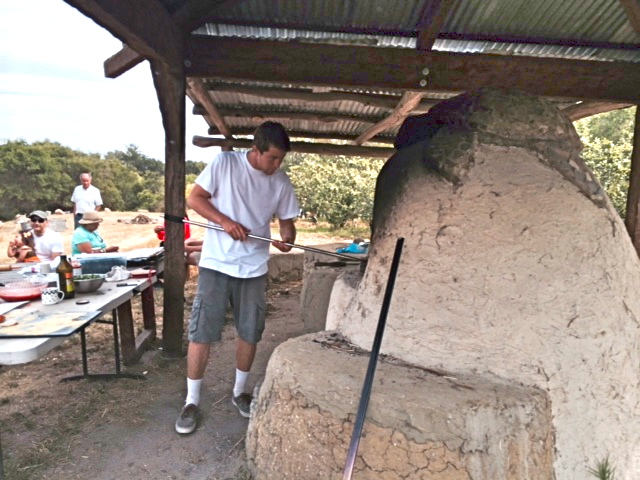
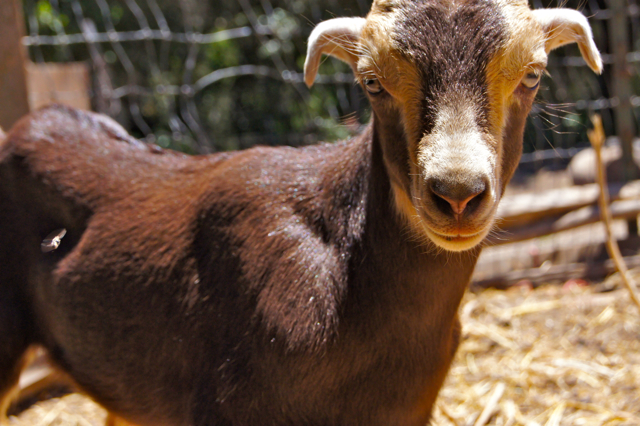
With summer upon us we have been enjoying an early harvest of apricots and green beans and as I assess the development of our peppers and dry-farmed tomatoes, they’re not far behind. Strawberries are slowing down, going through their normal cycle of adjusting to long days, the raspberries and blackberries however will be picking up the slack. All our winter squash plants are sown, and by next week basil should fill your shares with its wonderful aroma. Enjoy these long summer days, especially the flavors, colors and textures unique to this season.
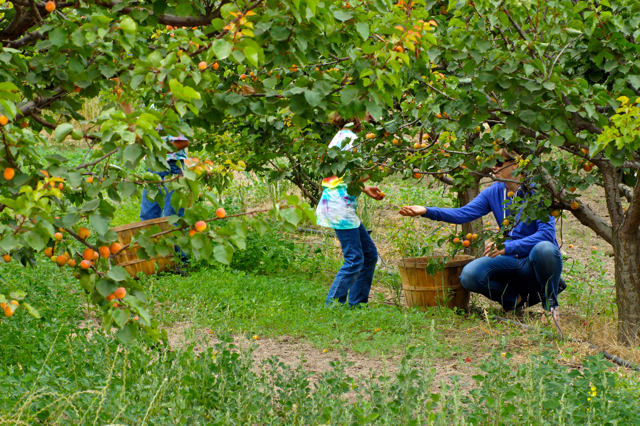
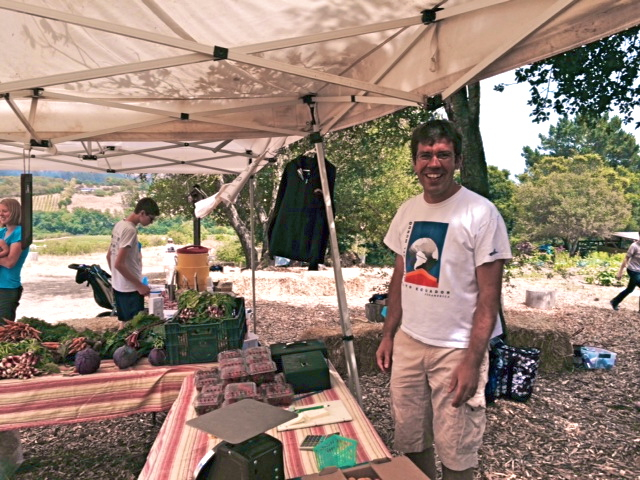
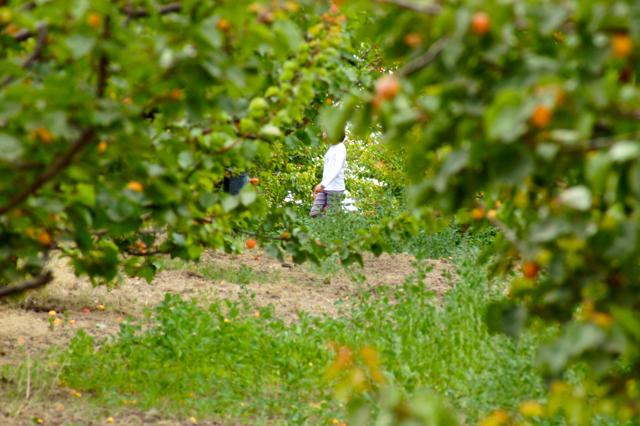
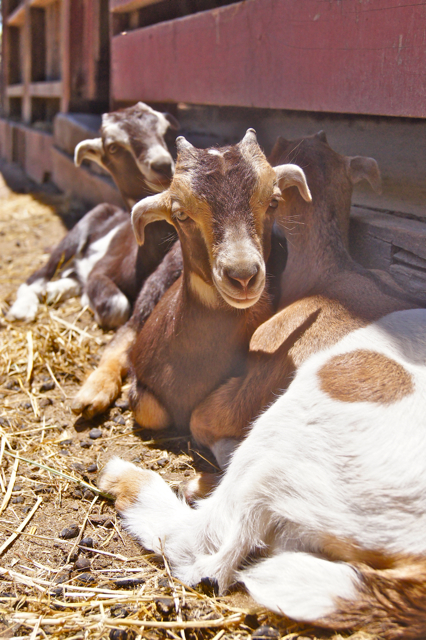
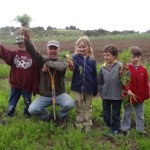 Planting Seeds of Nourishing Opportunities
Planting Seeds of Nourishing Opportunities
Our Annual Discovery Program Fundraiser, happening this Saturday, is sold out. This is a first! We are excited and grateful to receive the increased support to continue expanding our on-farm educational efforts in our community and the region.
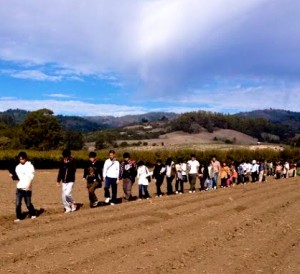 On the farm, close to nature, where you can see how plants and animals live, the Discovery Program offers an opportunity to directly participate in growing, harvesting, and cooking to inspire a deeper connection and understanding of how food choices influence our diet, the health of our bodies, and ultimately that of our planet.
On the farm, close to nature, where you can see how plants and animals live, the Discovery Program offers an opportunity to directly participate in growing, harvesting, and cooking to inspire a deeper connection and understanding of how food choices influence our diet, the health of our bodies, and ultimately that of our planet.
Every year over 1,500 children and young adults come to the farm to experience hands-on where and how food is grown. Less than 50 years ago we didn’t have the vast amount of processed and fast food options we have today. Our meals now are often “tainted” with processed additives, sweeteners, fats and salts, many of which are making the dubious claims of being healthy. If it was up to today’s industrial food industry, no one would be eating meals prepared and cooked “from scratch” using fresh produce, fish, meat or dairy products supplied directly from local farms.
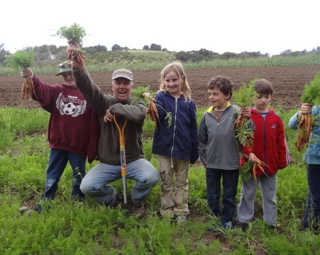 Our mission has always been about nourishing direct relationships and experiences that put healthy sustainable food and farming at the center of what defines our social, economic, and environmental wellbeing. It is exciting to see signs that this awareness is starting to translate into an increased demand for organic, locally grown food, with more farms, grocery stores, schools, restaurants, CSAs and Farmers Markets supporting the framework of a more resilient regional food system.
Our mission has always been about nourishing direct relationships and experiences that put healthy sustainable food and farming at the center of what defines our social, economic, and environmental wellbeing. It is exciting to see signs that this awareness is starting to translate into an increased demand for organic, locally grown food, with more farms, grocery stores, schools, restaurants, CSAs and Farmers Markets supporting the framework of a more resilient regional food system.
Thank you for all your support to continue our farming and educational efforts on this land here in the wonderful Pajaro Valley.
